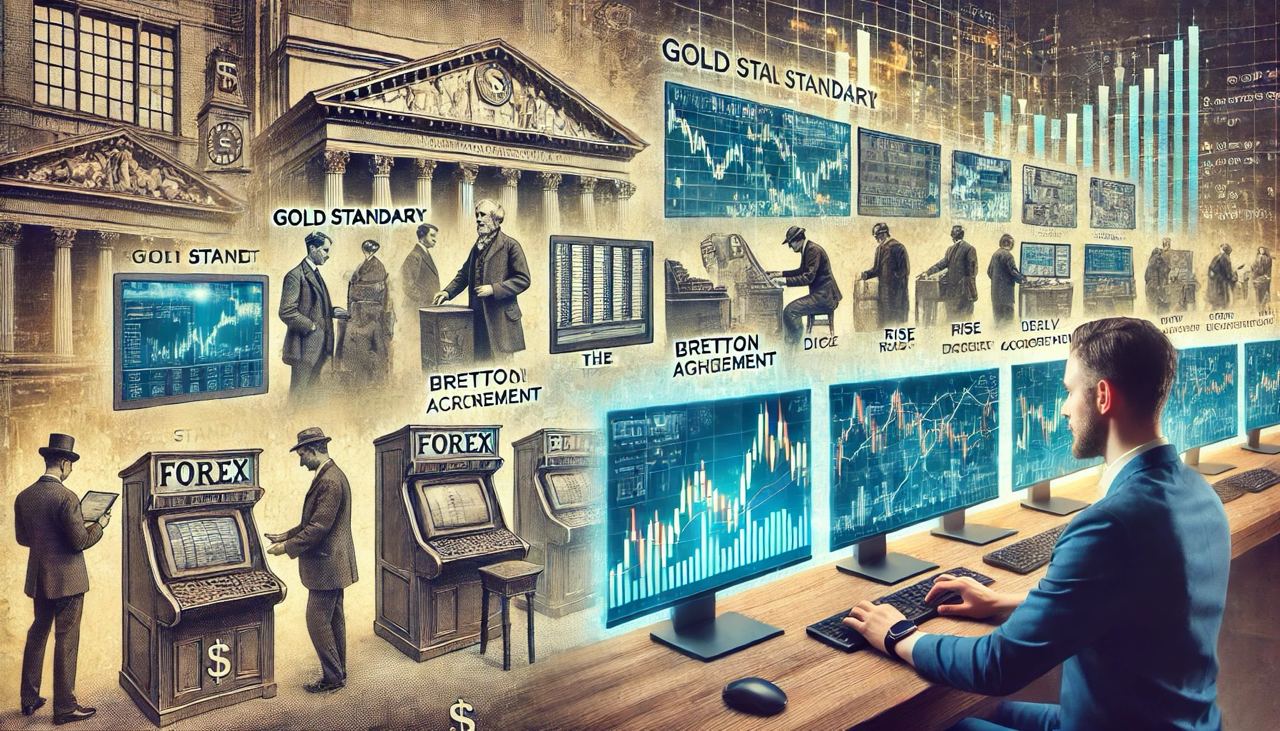Learn Trading for Free and Without Registration
An Online Glossary to Study Trading Independently
History of the Forex Market
The History of Forex: From the Gold Standard to a Global Financial Giant

The history of the Forex (FOREX) market is a fascinating journey through economic, political, and technological eras. Today, Forex is the largest financial platform in the world, with a daily turnover exceeding $7.5 trillion. However, its formation went through many stages, from fixed exchange rates and the gold standard to the decentralized market we know today.
The Early Stages of Currency Operations
The Gold Standard (19th Century – Early 20th Century)
The idea of pegging currency value to gold emerged in the 19th century when global economies began using gold as the benchmark for calculating the value of their national currencies.
-
Essence of the Gold Standard:
Each currency had a fixed value expressed in gold. For example, one British pound was equivalent to a specific amount of gold. -
Advantages:
- Stable exchange rates relative to one another.
- Facilitated international trade due to fixed rates.
-
Disadvantages:
- Limited flexibility: countries couldn’t adjust their currency values to stimulate their economies.
- Dependence on gold reserves.
The gold standard operated effectively until the First World War. The war necessitated increased government spending, leading to the abandonment of gold-backed currencies.
The Interwar Period: Chaos and Currency Wars
After World War I, exchange rates were chaotic. Without a gold peg, countries began manipulating their currencies to boost exports and overcome economic difficulties.
- Example:
In the 1920s, Germany faced hyperinflation, and the value of the German mark plummeted so rapidly that prices of goods changed multiple times a day.
These issues highlighted the need for a stable currency regulation system.
The Bretton Woods System (1944–1971)
In 1944, representatives of 44 countries gathered in Bretton Woods, USA, to discuss a new international monetary system.
Key Principles of the Bretton Woods System:
- Pegging the US Dollar to Gold:
One dollar was valued at $35 per ounce of gold. - Pegging Other Currencies to the US Dollar:
Other currencies were fixed to the dollar within a 1% fluctuation range. - Establishment of the International Monetary Fund (IMF):
The IMF was created to oversee compliance and provide financial assistance to countries.
Advantages of the System:
- Stable exchange rates facilitated international trade.
- The dollar became the world’s reserve currency.
Crisis of the Bretton Woods System:
By the 1960s, the demand for gold outpaced supply. The US began facing difficulties as gold reserves dwindled while the dollar supply expanded.
- 1965–1971: Countries like France demanded gold in exchange for dollars, depleting US gold reserves.
- 1971: US President Richard Nixon officially ended the dollar's convertibility to gold, marking the collapse of the Bretton Woods system.
Transition to Floating Exchange Rates: The Jamaican System (1978)
Following the collapse of the Bretton Woods system, the world transitioned to a new monetary order, known as the Jamaican system, officially adopted in 1978.
Core Principles of the Jamaican System:
- Floating Exchange Rates:
Exchange rates were determined by market supply and demand. - Abandoning the Gold Standard:
Gold was no longer used as the basis for currency valuation. - IMF’s Role:
The IMF continued to provide financial support but played a reduced regulatory role.
Impact on the Market:
- Exchange rates became highly volatile, attracting speculators.
- Central banks began actively using interest rates and interventions to regulate currency values.
Modern Forex Market: From Banks to Retail Traders
1980s: The Era of Globalization
With the advent of electronic communications, international currency trading became more accessible. Banks adopted electronic platforms to facilitate trading, speeding up transactions.
1990s: Emergence of Trading Platforms
The internet made the Forex market accessible to retail traders. Platforms like MetaTrader allowed individual investors to participate in trading.
2000s: Increased Regulation
Global financial crises, including the 2008 crisis, underscored the need for strict Forex market regulation. Laws were introduced to protect investors and combat fraud.
Structure of the Modern Forex Market
-
Major Banks:
They generate up to 50% of the market's turnover. -
Investment Funds and Corporations:
Use the market to hedge risks. -
Retail Traders:
Account for about 5–10% of the total turnover. -
Brokers and Market Makers:
Provide access to the market.
Key Events That Shaped the Forex Market
-
The British Pound Crisis (1992):
George Soros made $1 billion speculating against the pound. -
Introduction of the Euro (1999):
The euro became the second most significant currency after the dollar. -
The 2008 Financial Crisis:
Led to a sharp increase in Forex market volatility.
The Future of Forex: Digital Currencies and De-dollarization
Today, the Forex market faces new challenges:
- De-dollarization:
Countries like China and Russia are actively reducing their dependence on the US dollar. - Digital Currencies:
Central banks are developing digital versions of their currencies, potentially altering trading mechanisms. - Growth of Retail Trading:
The number of retail traders continues to grow, expanding market volumes.
Conclusion
The history of Forex is a story of innovation, crises, and adaptation to new realities. From the gold standard to digital currencies, the market has evolved to become an integral part of the global economy.
If you want to delve deeper into the Forex market and become a successful trader, start with education. Ronin Academy offers high-quality training, tools, and support to transform a beginner into a professional trader.


